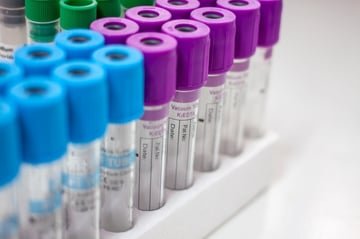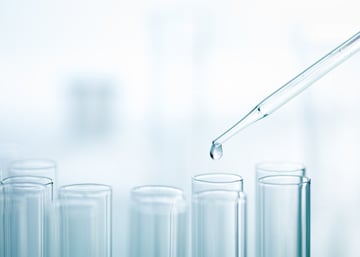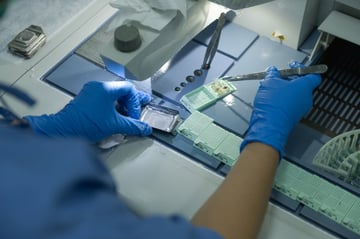
Anatomic and Digital Pathology Services
Integrating Traditional and Digital Pathology to Advance Clinical Development
From digitized slide reviews to expert biomarker interpretation, IQVIA Laboratories delivers an integrated approach to anatomic and digital pathology that accelerates clinical development. Our globally harmonized laboratories—spanning the Americas, Europe, and Asia-Pacific—follow standardized SOPs and validated workflows to ensure consistency and reproducibility across trial sites. With 35+ subspecialty pathologists trained in both traditional and digital review, we combine scientific rigor with cutting-edge tools, including custom image analysis powered by AI. Through fully validated, GxP-ready platforms for scanning, remote access, and image management, we offer the flexibility, speed, and insight needed to move from discovery to decision—confidently and at scale.
Digital Pathology Innovation
A Digitized Approach for Faster, More Accurate Decision-Making
With rising demand for precision and speed in clinical trials, IQVIA Laboratories has implemented fully digital pathology workflows across our global labs. Each site is equipped with identical infrastructure and has undergone end-to-end validation to ensure reproducible, regulatory-ready results—whether for exploratory research or registrational non-CDx submission.
Key Capabilities:
- Image Acquisition
Epredia 3DHISTECH Pannoramic 250 (bimodal: brightfield and fluorescent) and Leica AT2 (brightfield) scanners
Standardized file formats: .MRXS and .SVS - SlideMaster conversion supports over 90% of file formats and unifies into one file format enhancing flexibility, compatibility, and workflow efficiency.
- Remote Pathologist Workstations
Barco medical-grade monitors for high-resolution, color-accurate review
Configured for in-lab and remote access to keep analysis timelines on track - Image Management System
Proscia Concentriq LS platform for study-specific image repositories, sponsor access, and collaborative case review - AI-Powered Image Analysis
Collaborative Partnerships to utilize foundational models within the field - Validation and Compliance
Full validation per CAP guidelines for IHC and H&E digital interpretation

AI Driven Image Analysis Ecosystem
Collaborative Partnerships to Accelerate Innovation
In a dynamic landscape without a single dominant image analysis platform, IQVIA Laboratories has built a flexible, best-in-class ecosystem of partners to ensure the right tools are applied to each study. Our “quiver of arrows” approach gives sponsors access to a broad range of validated solutions tailored to unique clinical needs.
We work closely with AI innovators, algorithm developers, and image platform providers to support exploratory and regulatory-ready applications—always with our expert pathologists guiding design, validation, and review.
Strategic Partnerships
- Aiforia
- Flagship Biosciences
- HistoIndex
- Lunit
- MindPeak
- Nucleai
- OracleBio
- PaigeAI
- PathAI
- Ultivue
- Vlsiopharm
Integration Capabilities
Our digital pathology platforms are designed for seamless compatibility with the Proscia Concentriq image management system, allowing for efficient organization, collaboration, and access to study-specific repositories. We support custom algorithm development and validation tailored to each trial’s unique endpoints, ensuring precision and flexibility in image analysis. Built on secure, cloud-based infrastructure (AWS), our solutions enable rapid deployment and remote accessibility across global trial teams.
Anatomic Pathology Services
Proven Anatomic Pathology for Complex Clinical Trials
While digital tools enable greater speed, scalability, and remote access, our roots in anatomic pathology remain essential to the accuracy and integrity of every trial we support. IQVIA Laboratories offers globally harmonized anatomic pathology services that span the full spectrum—from routine histology and immunohistochemistry to complex multiplex IHC and companion diagnostics. With decades of experience and CAP-accredited labs across the Americas, Europe, and Asia-Pacific, our teams are built for scale without compromising on scientific rigor. Each study benefits from customized workflows based on tissue and tumor type, staining protocols, and assay requirements, with direct oversight from our 40 board-certified pathologists representing key subspecialties. Whether supporting exploratory biomarker discovery or regulatory submission, our anatomic pathology capabilities provide the foundation for high-quality data and reliable decision-making across every phase of development.
Advance your research
with proven
anatomic pathology expertise
Roll over icons to learn more
• Tissue fixation, processing, embedding, sectioning, and staining.
• Advanced methods including immunohistochemistry (IHC) and in situ hybridization (ISH).
• Automated and manual microtomy available depending on study needs.
Oncology & Biomarker Specialization
Anatomic Pathology Aligned with Your Biomarker Strategy
From PD-L1 scoring to complex multiplex tissue biomarker analysis, our anatomic pathology experts play a critical role in advancing oncology research and beyond. IQVIA Laboratories supports biomarker development strategies that inform patient selection, therapeutic targeting, and trial design—aligned with both clinical endpoints and regulatory requirements. Our pathologists identify and annotate regions of interest, enabling precise downstream testing such as ctDNA extraction, NGS, or molecular profiling. With deep experience in immuno-oncology and combination therapy trials, we also offer robust support for multiplex IHC, allowing multiple markers to be evaluated from minimal tissue. Whether your needs are exploratory or part of a companion diagnostic submission, our AP services are built to deliver high-impact, tissue-based insights at global scale.

Supporting biomarker development
- PD-L1 IHC and other predictive tissue biomarkers
- Tumor-infiltrating lymphocyte (TIL) evaluation
- Multiplex IHC development in collaboration with Ultivue for exploratory endpoints
- Pathologist-guided sample selection for molecular testing, ctDNA, and NGS
Unified Digital + Anatomic Approach
Seamless Integration of Technology and Expertise
Digital innovation doesn’t replace pathology—it enhances it. At IQVIA Laboratories, our pathologist-centric model ensures that human expertise remains at the heart of image interpretation, while digital tools accelerate discovery and drive efficiency.
Advancing Pathology Through Innovation:
- 2+1 adjudicatory model enabling collaborative review of complex cases
- Image augmentation for algorithm training across varied stain quality
- Foundation models built from large, diverse image datasets
- Ongoing fine-tuning of AI tools to align with clinical endpoints and research goals

Related Services

Bioanalytical Services
Learn more
ADME / DMPK Services
Learn more
Biomarker Services
Learn more
Biotech Laboratory Solutions
Learn more
Central Laboratory Services
Learn more
Clinical Genomics Laboratory Services
Learn more
Companion Diagnostics (CDx)
Learn more
COVID-19 Clinical Trial Solutions
Learn more
Flow Cytometry Assay Development
Learn more
Translational Science and Innovations Laboratory Services (TSAIL)
Learn more

